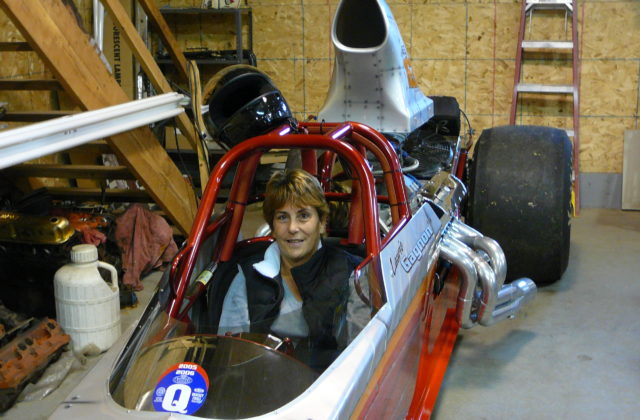Norfolk’s Gagnon Family Enjoys Drag Racing
Rev up your engines!
By Bob Bumcrot
Until 1978, the beautiful 1817 house and land on Winchester Road at the Norfolk-Goshen border was Wade Beecher’s dairy farm. A nearby building now houses not farm equipment but two sleek 1000-horsepower drag racers, a modified stock dragster and other vehicles that have been lovingly restored or are in the process.
Laurie Beecher Gagnon, her husband of 30 years James and their daughter Kristin, 24, are active drag racers at several tracks, especially Lebanon Valley Dragway in West Lebanon, New York. Their son, Jim Jr., who won the high school championships at Lebanon in 1997 and 1998, is now more interested in restoring “muscle cars,” such as the Ford Mustang and Pontiac GTO. Each Gagnon has a drag racing license from the National Hot Rod Association, which requires an airline-pilot-level physical and six supervised test runs.
James started drag racing as a teenager, moving from street races to Northeast division one bracket and top dragster class. In 1988 he was the Lebanon track champion. Laurie, who used to drive the tow car and make home movies of the competition, got hooked on racing about twenty years ago. In the early days, she would cover the quarter mile distance in about seventeen seconds, crossing the finish line at around 80 mph. Her elapsed times are now around 7.5 seconds, with finish line speeds approaching 180 mph. Kristin began as a grade-school student drag racing bicycles on a 60-foot strip near the Lebanon track, where she regularly beat teenagers. In 1999, aged 16, she won the track high school championship, and in 2000 she went on to win the entire Northeast division.
There are over 200 dragstrips in North America, some one-eighth mile but most a quarter mile in length. Two competitors line up and rev up their engines. A special light display, universally called the “Christmas tree,” flashes a descending series of amber lights exactly 0.500 seconds apart ending with a green light when the racers start. A sophisticated timing system measures to the nearest thousandth of a second the reaction times of the drivers, their times at 60 feet, 330 feet, 1/8 mile, 1000 feet and 1/4 mile, and their speeds at 1/8 and 1/4 mile. A start before green results in disqualification, so a perfect reaction time would be 0.000 seconds.
Here is a summary of a race Laurie won in August: Reaction time 0.051sec, 1/8 mile 4.951sec, 139.05 mph, 1/4 mile 7.795sec, 171.90mph. Her opponent’s reaction time was 0.094 seconds, good but not good enough.
Laurie’s car, which is similar to James’s, has a 2004 Undercover chassis with a 235 inch wheel base and a 555 cubic inch engine by Scott Shafiroff. The two-speed transmission is automatically up-shifted by an air-driven system but, of course, is manually engaged at the green light by a button on the tiny steering assembly. While these cars are equipped with rear parachutes to stop the car after it crosses the line, they are rarely deployed at Lebanon, which has a long deceleration track.
For comparison, the leading pro racers have enormous machines with 8000-horsepower engines that cover the distance in around four seconds and cross the line at 300mph. These vehicle would probably burn out if run more than a few minutes. But the Gagnons’ cars are equipped with a radiator that could allow one to drive (slowly) in the August 2, 2008 parade celebrating Norfolk’s semiquincentennial.
Photo, top, of Laurie Gagnon, drag racer, by Bob Bumcrot.

